Mark Sisson's Blog, page 34
December 4, 2021
Low-carb TikTok Inspired Salmon Rice Bowls
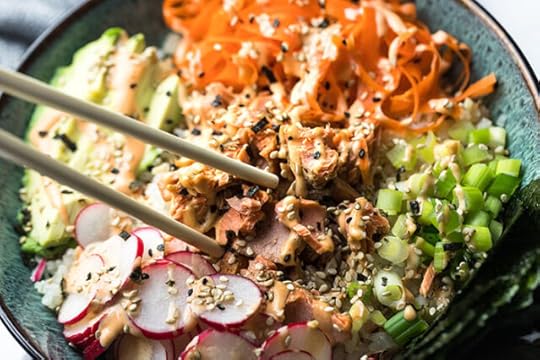 If you’re on TikTok and you come across food and recipe videos from time to time, there’s no doubt you’ve seen Emily Mariko’s viral Salmon Rice recipe. Here at Mark’s Daily Apple, we swooned as hard as everyone else, but wanted a lower carb, grain-free option.
If you’re on TikTok and you come across food and recipe videos from time to time, there’s no doubt you’ve seen Emily Mariko’s viral Salmon Rice recipe. Here at Mark’s Daily Apple, we swooned as hard as everyone else, but wanted a lower carb, grain-free option.
We got to work on making a Primal version, and we finally get to see what all the excitement is about. Well, it lives up to the hype, and it’s going into our weekly rotation. The best part is, if you keep salmon and cauliflower rice in the freezer, you’ll probably have the ingredients on hand to adapt the recipe according to what’s in your fridge.
Here’s how to make it.
Low-carb TikTok Inspired Salmon Rice Bowls

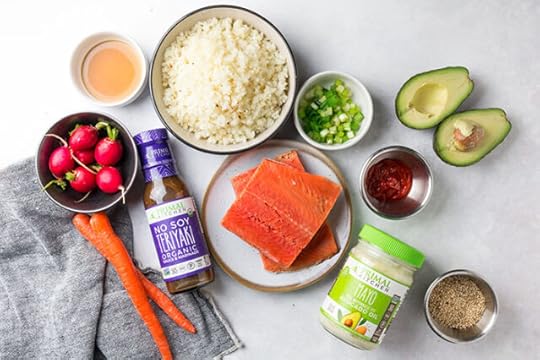 Directions
DirectionsPlace the salmon portions in a glass dish. Combine the sesame oil and teriyaki sauce in a small bowl and pour the mixture all over the salmon.
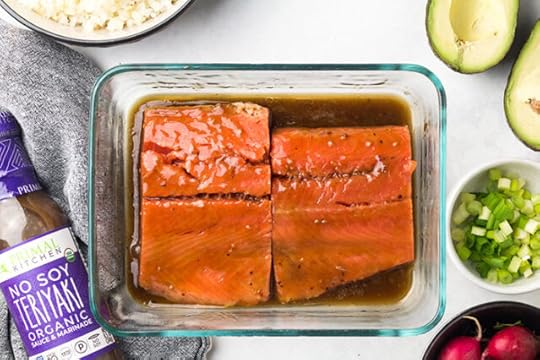 Bake the salmon at 375 degrees for about 12-15 minutes, or until the internal temperature reaches at least 145 degrees Fahrenheit.
Bake the salmon at 375 degrees for about 12-15 minutes, or until the internal temperature reaches at least 145 degrees Fahrenheit.
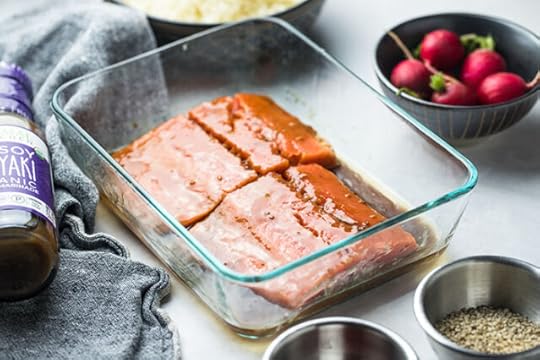
Roast your cauliflower rice on a sheet pan until it is tender but not too browned.
When the salmon is fully cooked and has cooled for a little bit, shred it with two forks. Toss half of the salmon with the cauliflower rice and place it into two bowls. Place the rest of the salmon on top of the cauliflower.
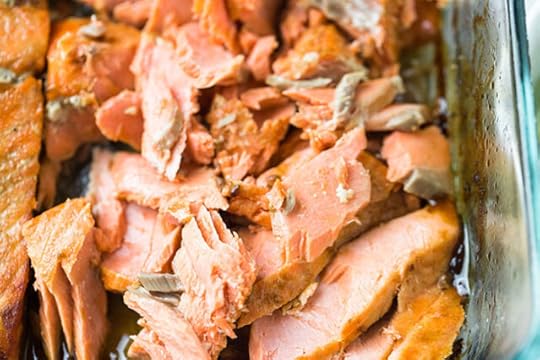
Add your favorite toppings to the bowl. We used peeled carrot, sliced radishes, scallions, and sliced avocado. You could also use things like kimchi, cucumbers, pickled radishes or onions. Feel free to top with more of the no soy teriyaki or some coconut aminos.
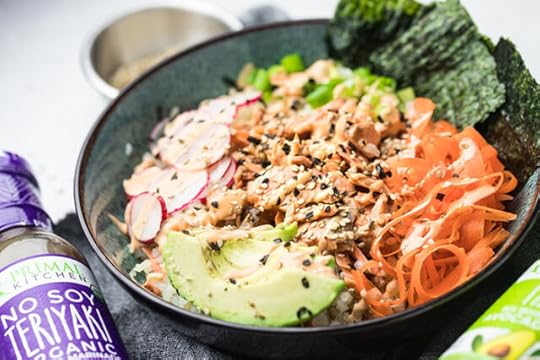
In a small bowl, mix together the mayo with as much or as little sriracha sauce as you’d like. Drizzle the spicy mayo on top of the bowls.

Garnish with sesame seeds or seaweed seasoning and place some nori sheet pieces on the side and enjoy!


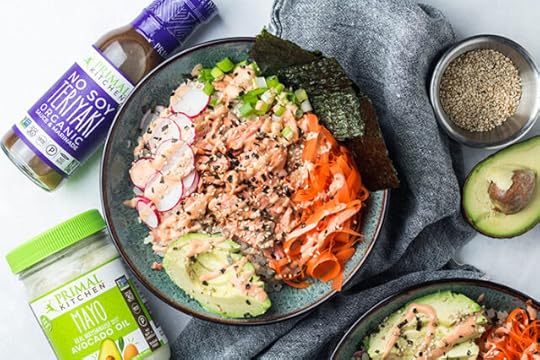
(function($) { $("#dfIzdN8").load("https://www.marksdailyapple.com/wp-ad..." ); })( jQuery ); 
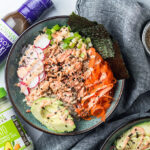 Low-carb TikTok Inspired Salmon Rice Bowls Author: Mark's Daily Apple
Low-carb TikTok Inspired Salmon Rice Bowls Author: Mark's Daily Apple  Total Time: 20 minutes
Total Time: 20 minutes  Yield: 2 large bowls Diet: Gluten Free [image error] Print Recipe [image error] Pin Recipe Description
Yield: 2 large bowls Diet: Gluten Free [image error] Print Recipe [image error] Pin Recipe Description These salmon rice bowls are inspired by those viral salmon rice bowls you’ve seen on TikTok, but adapted for a low-carb and grain-free lifestyle!
Ingredients Ingredients2 6oz. wild-caught salmon portions
3 tablespoons Primal Kitchen® No Soy Teriyaki
1 tablespoon sesame oil
4 cups cauliflower rice (I used frozen)
Nori sheets
Sesame seeds
More No Soy Teriyaki or coconut aminos
Toppings Options1 shredded carrot
6 sliced radishes
3 chopped scallions
1 sliced avocado
Kimchi
Cucumbers
Daikon
Snap peas
Shredded bell pepper
Pickled veggies
Pickled onion
Fried egg
Spicy Mayo3 tablespoons Primal Kitchen Mayo
Sriracha sauce, to taste
InstructionsPlace the salmon portions in a glass dish. Combine the sesame oil and teriyaki sauce in a small bowl and pour the mixture all over the salmon. Bake the salmon at 375 degrees for about 12-15 minutes, or until the internal temperature reaches at least 145 degrees Fahrenheit.
Roast your cauliflower rice on a sheet pan until it is tender but not too browned.
When the salmon is fully cooked and has cooled for a little bit, shred it with two forks. Toss half of the salmon with the cauliflower rice and place it into two bowls. Place the rest of the salmon on top of the cauliflower.
Add your favorite toppings to the bowl. We used peeled carrot, sliced radishes, scallions, and sliced avocado. You could also use things like kimchi, cucumbers, pickled radishes or onions. Feel free to top with more of the no soy teriyaki and/or some coconut aminos.
In a small bowl, mix together the mayo with as much or as little sriracha sauce as you’d like. Drizzle the spicy mayo on top of the bowls.
Garnish with sesame seeds or seaweed seasoning and place some nori sheet pieces on the side and enjoy!
NotesThese bowls can be made with leftover salmon or other proteins like shredded chicken or steamed/sauteed shrimp. You can also put a fried egg on top.
 Prep Time: 5 min
Prep Time: 5 min Cook Time: 15 min
Cook Time: 15 min Category: Lunch, Dinner
Category: Lunch, Dinner Method: Baking
Method: Baking Cuisine: Asian Nutrition Serving Size: 1 bowl Calories: 630.8 Sugar: 11.1 g Sodium: 735.5 Fat: 43.4 g Saturated Fat: 6.1 g Unsaturated Fat: 17.74 g Trans Fat: .39 g Carbohydrates: 23.4 g Fiber: 10.3 g Protein: 43.9 g Cholesterol: 109.2 mg Net Carbs: 12.98 g
Cuisine: Asian Nutrition Serving Size: 1 bowl Calories: 630.8 Sugar: 11.1 g Sodium: 735.5 Fat: 43.4 g Saturated Fat: 6.1 g Unsaturated Fat: 17.74 g Trans Fat: .39 g Carbohydrates: 23.4 g Fiber: 10.3 g Protein: 43.9 g Cholesterol: 109.2 mg Net Carbs: 12.98 g Keywords: tiktok salmon bowls, emily mariko salmon, viral salmon bowls, low-carb emily mariko salmon, low-carb salmon bowls
 Did you make this recipe?
Did you make this recipe? Share a photo and tag Mark's Daily Apple — we can't wait to see what you've made!
The post Low-carb TikTok Inspired Salmon Rice Bowls appeared first on Mark's Daily Apple.


December 3, 2021
New and Noteworthy: What I Read This Week—Edition 156
 Research of the Week
Research of the Week
Asexual identifying people tend to invest less in both romantic and platonic relationships.
Grazing is good for the soil and biodiversity (again).
Exercising as you enter a fast can help you hit ketosis faster.
Whether you went to college can predict (but not cause) long term brain health and function.
Your circadian rhythm affects energy balance.
Episode 8: Mark Sisson Holiday Q&A
Episode 9: Bar Malik: The former NBA Director of Performance discusses his new optimized sports drink, Barcode.
Primal Health Coach Institute: Dr. Shamini Jain on why we are our best healers.
Media, SchmediaI’m not so sure on psychedelic telemedicine.
Giant mammoths in the ocean. The world and its past are far stranger than you could ever realize.
Interesting Blog PostsInositol can really help women with PCOS.
Males aren’t supposed to be this infertile, folks.
Social NotesNow that’s an open letter: one imploring a region in India to start providing eggs to children in poverty.
Nature is beautiful but dangerous.
Everything ElseThese bees got straight As in school.
Don’t do this (with yours or anyone else’s).
We still don’t know how fish schools work, or why.
Things I’m Up to and Interested InInteresting: Prozac helps against COVID.
Well-deserved: The backlash against “plant-based” foods.
Overrated: Plants as carbon sinks.
Underrated: Soil as carbon sink.
Question I’m AskingWhat is your dream charity?
Recipe CornerIncredible paleo fried calamari.More bone broth recipes than you’ll ever need.Time CapsuleOne year ago (Nov 27 – Dec 3a)
How to Recover From Holiday Overindulgence— How to do it.Primal Gift Guide 2020— What to buy.Comment of the Week
“Regarding growth issues. Males may need much more zinc to grow to their full potential. Eating zinc-rich foods like liver might not be enough. First there is type-II zinc deficiencies, which can be caused by something as insidious as delayed hypersensitivities to foods, or spores or mycotoxins in the air breathed while sleeping. Second, males who discover the joys of masturbation can lose zinc in ejaculate. Another observation by a colleague was that “catch-up growth” frequently occurred when a zinc insufficiency was corrected. One boy grew six inches in less than a year. So maybe a trial of zinc for a month would be worth it? Maybe medical monitoring of copper status during the month for optimizing safety?”
-One of many great comments.
(function($) { $("#dfhX419").load("https://www.marksdailyapple.com/wp-ad..." ); })( jQuery ); 
The post New and Noteworthy: What I Read This Week—Edition 156 appeared first on Mark's Daily Apple.


December 2, 2021
Ask a Health Coach: Why You’re Confused About What (and When) to Eat
 Hi everyone, this week Erin is back to answer more of your health and wellness questions. If you’re confused about carb intake, curious if you should really eat breakfast, or wondering how to stay on track during the holidays, read on for this week’s edition of Ask a Health Coach. Got a question for Erin? Post it in the comments below or over in the Mark’s Daily Apple Facebook group.
Hi everyone, this week Erin is back to answer more of your health and wellness questions. If you’re confused about carb intake, curious if you should really eat breakfast, or wondering how to stay on track during the holidays, read on for this week’s edition of Ask a Health Coach. Got a question for Erin? Post it in the comments below or over in the Mark’s Daily Apple Facebook group.
Melissa asked:
“I’ve been hearing a lot about carbs now being good for you, especially if you have adrenal issues. I thought carbs were supposed to be bad. What’s the straight answer?”
There’s nothing I love more than to rehash the old “good foods/bad foods” debate that diet culture continually smothers us with. Internet influencers try to demonize whole food groups and steer us in the all-or-nothing camp so often, it’s no wonder people are confused about what they should be eating.
The truth is, many foods, good and bad, contain carbohydrates (cookies, cakes, kale, carrots, green beans, bagels, beets…the list goes on). And when you consume those foods, your digestive system breaks the carbs down into glucose, aka sugar, which enters the bloodstream. As blood sugar levels rise, the hormone insulin is released, prompting your cells to absorb sugar from the blood. When blood sugar starts to get low, another hormone, called glucagon, takes that absorbed sugar and uses it for energy. Our bodies are seriously miraculous, aren’t they?
Managing Adrenal Fatigue with FoodThe thinking behind recommending more carbs for those with adrenal issues, is that it can be more difficult for your body to metabolize protein and fat for energy. That being said, when you consume more carbohydrates than your body needs, or highly processed, sugary foods, your blood sugar rises higher and crashes lower (going beyond normal the insulin-glucagon response) and causes a spike in the stress hormone, cortisol. You’re inadvertently causing more stress in your body — not something you want to do if you’re trying to manage adrenal dysfunction.
Do this on a regular basis and you’ll be on a metabolic rollercoaster that makes your adrenals work even harder. Even conventional medicine agrees that processed foods and refined sugars increase cortisol and can lead to unhealthy crashes.https://www.endocrineweb.com/conditio...
The goal, really for everyone, is to keep your blood sugar stable. And the best way to do that is to eat nutrient dense foods at every meal. Notice I said “meal” and not “snack” since under-eating is another form of stress on the body. Focus on consuming protein, healthy fats, and complex carbohydrates like sweet potatoes, root veggies, and leafy greens.
If you tried eating low carb for a while and it made your symptoms worse, eat more. Yes, even if you’re creeping into the 100–150-gram range. Eating a ton of carbs and still feel like crap? Eat fewer. And if you’re loading up on processed energy bars, assuming that they’re healthy, swap them out for whole foods for a few weeks.
As a parting thought, what if you forgot all the food rules for a minute and leaned into listening and trusting your body’s signals? No one knows your body better than you do.
Lee asked:
“I’ve been following Primal for a good part of a year and don’t think I can commit to staying on track during the holidays. We’re having a lot of family in town and I won’t be able to do all my usual shopping, meal prep, and workouts. How do I survive the holidays and not totally derail my progress?”
Sure, the holidays are a busy time of year. But honestly, when isn’t life busy? If it’s not the holidays, it’s the school year, or summer break, or you’re starting a new job or relationship or whatever.
I hear this with my health coaching clients all the time. When life gets busy, they decide they need to take a break on the “health stuff.” Instead of dialing it back, they do nothing. At all.
How to Stay on Track During the HolidaysIf I could share one piece of advice with you today, it’s that your health doesn’t need to have an on/off switch. This isn’t an all-or-nothing situation where you’re either nailing it or falling off the wagon.
Think of your health like an adjustable dial. Can’t crank it all the way up to 10 right now because you’re hosting the holidays at your place? Great, how about a 7 or a 5? Heck, even a 2 is better than nothing. Maybe you can’t do all your usually shopping, meal prep, and workouts, but I bet you could:
Eat at least one healthy meal per dayPut a few veggies on your plateGo for a walkEat some proteinDrink a glass of waterGo to bed early once or twiceHave a fresh piece of fruitDo a 1-minute meditationBreatheThe goal is to preserve the momentum you’ve got going so that if/when life does slow down, you can ramp it back up. It’s way easier to dial things up from a 2 than to completely abandon all the healthy habits you’ve established and start from scratch.
Also, remember that just like one healthy meal won’t make you fit, one unhealthy meal or missed workout won’t derail your progress. Some sort of consistency is your best bet. During the holidays and all year long.
Joon asked:
“I wake up in the morning with a growling stomach. I read in Mark’s book you’re supposed to wait until you’re hungry, yet it’s best to put off eating in the morning if you can. Should I eat? I feel like I might harm someone if I didn’t, lol.”
I’m going to make this really simple for you, Joon. If you’re hungry, eat. The first rule I teach my clients is “Always answer hunger with a meal.” (Please note: I’m not an IF coach)
I mean, how much easier does it get than that? You’ve been given the gift of recognizing your hunger cues — a gift a lot of folks out there would gladly take off your hands. Your body is telling you it’s hungry and all you have to do is respond by giving it food.
The Benefits of Eating BreakfastYes, there are benefits to fasting. But there are also benefits to eating in the morning, especially if you’re feeling hungry. Maybe you saw this study from University of Alabama at Birmingham about early time-restricted feeding (eTRF). Participants were put into two groups: one ate from 8am to 2pm; the other ate from 8am to 8pm. Both groups ate the same foods and same number of calories, but researchers found that the meal-timing strategy of the first group reduced swings in hunger and altered fat and carbohydrate burning patterns.
Or this study where 93 participants between the ages of 30 and 57 were put into two isocaloric weight loss groups: one had their largest meal of the day at breakfast; the other had their largest meal at dinner. Over the course of 12 weeks, the group who consumed the most calories at breakfast lost two and a half times more weight than those who had a light breakfast — or skipped it altogether. They also had significantly reduced fasting glucose, insulin, ghrelin, and triglyceride levels.
If your natural rhythm is to eat earlier in the day, there’s no reason to fight that. There’s no reason to white knuckle it through the first few (or several) hours, just because some people have success with that.
The Number One Rule of HungerHere’s what not to do when your stomach growls: ignore it. We’ve been programmed to believe that hunger is a sign of weakness — something we should push through. Or even better, that if we feel hungry, we’re actually thirsty and that we should go have a glass of water instead of sitting down for a meal.
If you’re hungry, eat. If you’re new to fasting, or recently switched from Standard American fare, you might start to notice a change over time and can push back your first meal if desired. But don’t feel compelled to exhibit great feats of willpower and ignore your hunger because you think you’re supposed to. That’s no way to live. #mytwocents
Got more questions? Ask ‘em below. Or check out the new myPrimalCoach where you can work 1-on-1 with your own health coach.
The post Ask a Health Coach: Why You’re Confused About What (and When) to Eat appeared first on Mark's Daily Apple.


December 1, 2021
The Definitive Guide to Sleep
 man’s best friend
man’s best friendSleep is the grand mystery of life. You get sleepy, you yawn, you lay your head down, and then you wake up. At some point, you drifted off to sleep and were unconscious, helpless, completely out of it for the better part of the night. Maybe faint glimmers of the moment before you fell asleep remain in your memory. If you remember your dreams, you’ve got those to fall back on—but they fade fast. No, for the most part we have no idea what happens when we sleep.
We do know what happens when we don’t. The list of maladies caused by and/or linked to sleep deprivation is long and exhausting.
What Happens When You Don’t Get Enough Sleep?The best way to understand why sleep is so important is to learn what goes wrong when you don’t get enough it.
Alzheimer’s, dementia, and cognitive dysfunctionInsulin resistance and diabetesLow testosteroneJunk food cravingsFat gainPremature agingPoor immune functionWorsened stress resilienceImpaired antioxidant statusPoor performance and results in the gymCognitive dysfunction
Sleep is when the brain does its “house cleaning,” where it floods with cerebrospinal fluid to flush out toxins and damaged proteins through channels that widen during sleep.https://www.nih.gov/news-events/nih-r... If you don’t get enough sleep, or you fail to reach the “deep sleep” phase of your normal sleep cycle, your brain can’t clear the damage. One night might not be a big deal, but weeks, months, and years of poor sleep where you fail to attain deep sleep will increase your chances of Alzheimer’s disease and general cognitive dysfunction.https://pubmed.ncbi.nlm.nih.gov/33004...
Insulin resistance and diabetes
One of the most reliable effects of a single night’s bad sleep is an increase in insulin resistance.https://pubmed.ncbi.nlm.nih.gov/29510... It’s such a reliable effect that researchers are always looking for supplements, nutrients, and interventions to counter the insulin resistance induced by bad sleep. Part of this is caused by a reduced ability of the sleepy liver to process fat; if a sleepy liver can’t process fat as well, it will accumulate it and turn insulin resistant. https://www.sciencedaily.com/releases...
Low testosterone
A sneaky hack to get a doctor to sign off on TRT for younger guys is to sleep 4 hours a night for a month leading up to your test. Your testosterone will plummet and the doctor is more likely to sign off on hormone replacement. I don’t advise anyone try this, but the fact remains that poor sleep is a great way to lower your testosterone levels.
Junk food cravings
A single night of bad sleep causes people to find junk food more rewarding.https://www.ncbi.nlm.nih.gov/pubmed/2... Patients on no sleep derived more pleasure from food, desired more food, and reported more hunger than patients who had slept. And that was just a single night. Just imagine the effects of days, weeks, or even years of chronic poor sleep.
Fat gain
Sleep restriction increases food intake, particularly snack intake. Moreover, it increases food intake without a concomitant increase in energy output. You eat more without moving more—and it happens spontaneously. Over time, an imbalanced energy intake/output will lead to body fat gain, particularly if you’re eating the kind of junk food that poor sleep compels most people to consume.https://pubmed.ncbi.nlm.nih.gov/27804...
Premature aging
The worse you sleep, the worse your skin ages. Sleep restriction is linked to an increase in facial aging and a decrease in skin barrier function.https://pubmed.ncbi.nlm.nih.gov/25266... Since several studies indicate that the perceived “age of the face” is a better predictor of mortality risk than objective health markers, actual age, or cognitive function, sleep induced facial aging will reflect real mortality effects.https://www.ncbi.nlm.nih.gov/pubmed/2...
Poor immune function
When you sleep poorly, you get sick more often. This is true in teens and in adults.https://pubmed.ncbi.nlm.nih.gov/24134...https://pubmed.ncbi.nlm.nih.gov/33997... In one paper, melatonin—the sleep hormone your body produces to prepare for bedtime—was one of the only supplements shown to be effective against COVID-19.https://pubmed.ncbi.nlm.nih.gov/32314... That’s no coincidence.
Worsened stress resilience
We’ve all had a bad night’s sleep and then spent the following day trying to fend off stressors that’d usually bounce off us. When you haven’t slept much, you’re more likely to get into arguments with your spouse and kids, get angry while driving, and snap at co-workers (or total strangers). In short, you are less stress-resilient. That’s not just a subjective impression. Objective measurements of stress resilience suffer after sleep restriction.https://pubmed.ncbi.nlm.nih.gov/29246...
Impaired antioxidant status
A single night of sleep deprivation reduces levels of glutathione, the body’s premier antioxidant that we use to combat oxidative stress and metabolize and nullify toxins.https://pubmed.ncbi.nlm.nih.gov/28738... If you’ve ever had a bad night’s sleep, the worst thing you can do is subject yourself to an oxidatively stressful event, like binge drinking.
Poor performance and results in the gym
If you don’t get enough sleep, everything involving physical training suffers. Your postural control and balance get worse, leaving you vulnerable to injury. Your actual performance suffers—you don’t run as fast or lift as much weight or have as much stamina. And your results aren’t as impressive. You don’t gain as much muscle or lose as much body fat.
What Are the Benefits of Good Sleep?A good night’s sleep is the foundation for a healthy, happy, productive existence. Good sleep staves off many of the bad things listed above. And without good, regular sleep, we just go through life in a scattered daze, everything foggy, slightly confusing, and less enjoyable. We’re not really ourselves if we haven’t slept. We desperately need a good night’s sleep, every night.
But good sleep isn’t just about avoiding the negative effects of not sleeping. Sleep is an incredibly active time for our bodies and brains when we undergo all manner of growth and repair processes through a dynamic biochemical orchestration. Sleep is key, essential, absolutely downright necessary for our basic physiological operations.
For one, you wouldn’t be the person you are without sleep. I mean that literally, since sleep spurs the release of human growth hormone (HGH), an essential player in cellular regeneration (and fat burning).
A full night of sleep won’t just reduce the risk of brain degeneration, it will enhance your memory performance and creative problem solving skills the next day, not to mention make you a better person to be around by helping you see the positive in your interactions.
A good night’s sleep will further boost your athletic performance, including speed, accuracy, mood and overall energy.https://www.sciencedaily.com/releases... College athletes who sleep two extra hours per night have more accuracy and faster sprint times.
Good sleep means you dream, and dreams are the way your brain deals with issues your conscious self cannot or will not. That’s hard to pin down as “objectively beneficial,” as you can’t really measure a dream, but the fact that we do dream means it’s important—and we should create situations (sleep) that allow us to dream.
How to Get Great SleepGreat sleep starts in the morning.
As soon as you’re awake, go outside and greet the sun. Get natural sunlight onto your body and into your eyes in order to “tell” your circadian clocks that the day has begun and you are awake. The more natural light you get in the daytime, the better you sleep at night.https://www.ncbi.nlm.nih.gov/pubmed/1...
Stand barefoot on the earth. Grounding is controversial, but I think there’s something to it and studies suggest that connecting to the earth with your bare skin can improve subsequent sleep.
Get some physical activity. Sex, exercise, a little light movement, a barefoot walk outside (which is efficient because it’s both light and movement and connection to the earth). The point is to move your body to give your circadian clock the message that you’re ready to live the day.
If you eat breakfast, eat plenty of animal protein. You don’t have to eat breakfast, although some people find it really helps them get better sleep. But if you do, make sure you’re eating protein, as meat-rich breakfasts have been shown to improve sleep.https://www.ncbi.nlm.nih.gov/pubmed/2...
Stop caffeine before noon. Caffeine taken after noon has the potential to impact your sleep.
Stop alcohol before 6 PM. The best thing for sleep is to not drink any alcohol at all, but if you’re going to drink, having your last one before 6 PM will reduce the chances of any sleep impairment.
Use blue blocking goggles after the sun goes down and/or eliminate the use of screens after dark. Blue light inhibits melatonin secretion and makes it much harder to get to sleep.
Take magnesium or apply magnesium oil to your body before bed. Magnesium is one of the most important minerals for optimal sleep and few people get enough in the diet.
Take collagen or drink bone broth before bed. The glycine in both improve sleep quality and really knock you out (in a good, healthy way).
Keep your room cool. 60-65 degrees is ideal. If you get hot in bed, stick a leg out from under the blanket.
If you want a more thorough treatment of my prescriptions for better sleep, read this post.
Are Naps Healthy?A nap is a great way to recover from a poor night’s sleep. A nap taken after sleep deprivation is full of REM sleep, more so than the equivalent amount of regular nighttime sleep.https://www.sciencedaily.com/releases... Furthermore, there are many proven benefits to napping, particularly if you’ve been skipping sleep:
Napping has been shown to help stave off jet lag.https://www.ncbi.nlm.nih.gov/pubmed/1... quick nap can be enough to overcome the negative effects of sleep deprivation on learning and memory.A study in Greek adults found that an afternoon nap was associated with improved heart health and reduced cardiovascular events.A mere 26 minute nap can boost performance by 34%.An afternoon nap improves post lunch “cognitive flexibility,” or the ability to multi-task.https://www.ncbi.nlm.nih.gov/pubmed/2... reduces stress, particularly the stress caused by sleep restriction.https://www.ncbi.nlm.nih.gov/pubmed/2... restores immune function impaired by sleep restriction.https://www.ncbi.nlm.nih.gov/pubmed/2...For a truly effective power nap, have a cup of coffee right before you lie down to sleep. You’ll wake up with the caffeine in full effect and stave off any sleep inertia.
How Much Sleep Do We Need?It depends on several variables.
Genetics: Though seven to eight hours is optimal for most people, some genuinely require nine or ten hours. A few lucky ones among us hit our optimum with only six or so hours of shut eye. (These folks are honest to goodness mutants, as science has confirmed.)
Age: However, the majority of our sleep differentiation is determined by age. Babies, no surprises here, need the most (however patchy it is), while adults require the least. The notion that older adults need less sleep is actually hogwash. Although sleep patterns become more fragmented as we age, we still need the same good old average. Sleep still fosters critical hormonal secretion (like growth hormone) necessary for healthy aging. One study in particular linked solid sleep with higher levels of testosterone in older men.https://www.ncbi.nlm.nih.gov/pmc/arti...
Children, however, are especially susceptible to the ravages of sleep deprivation. Sleep is essential for babies to learn and retain new information. Sleep deficits have been long been linked to an increased risk of ADHD, depression and behavioral problems in children.https://pediatrics.aappublications.or...https://www.sciencedaily.com/releases...
Exercise: The more and harder you train, the more sleep you need—not only to reap the benefits of your training, but to recover from it. Anyone who demands more from their body will require more sleep.
In today’s world rife with responsibilities, early wake-ups, late night disasters, electronic temptations, notifications, work emails, blaring televisions, and glaring lights, sleep can feel like a luxury—or a burden. But sleep is one of the non-negotiables I talk about so much. If you can focus and nail your sleep, make it a sacred component of your lifestyle that you simply do not compromise on, you will reap untold benefits and avoid terrible maladies.
Good night.
Thanks for reading. Be sure to send along your thoughts. I’ll look forward to reading your comments!
(function($) { $("#dfgjsPH").load("https://www.marksdailyapple.com/wp-ad..." ); })( jQuery ); References https://www.nih.gov/news-events/nih-research-matters/how-sleep-clears-brainhttps://pubmed.ncbi.nlm.nih.gov/33004510/https://pubmed.ncbi.nlm.nih.gov/29510179/https://www.sciencedaily.com/releases/2010/05/100505091632.htmhttps://www.ncbi.nlm.nih.gov/pubmed/22259064https://pubmed.ncbi.nlm.nih.gov/27804960/https://pubmed.ncbi.nlm.nih.gov/25266053/https://www.ncbi.nlm.nih.gov/pubmed/22753633https://pubmed.ncbi.nlm.nih.gov/24134661/https://pubmed.ncbi.nlm.nih.gov/33997896/https://pubmed.ncbi.nlm.nih.gov/32314850/https://pubmed.ncbi.nlm.nih.gov/29246812/https://pubmed.ncbi.nlm.nih.gov/28738082/https://www.sciencedaily.com/releases/2008/06/080609071106.htmhttps://www.ncbi.nlm.nih.gov/pubmed/18815716https://www.ncbi.nlm.nih.gov/pubmed/23705838https://www.sciencedaily.com/releases/2008/06/080610071936.htmhttps://www.ncbi.nlm.nih.gov/pubmed/19147377?ordinalpos=2&itool=EntrezSystem2.PEntrez.Pubmed.Pubmed_ResultsPanel.Pubmed_DefaultReportPanel.Pubmed_RVDocSumhttps://www.ncbi.nlm.nih.gov/pubmed/26016658https://www.ncbi.nlm.nih.gov/pubmed/25668196https://www.ncbi.nlm.nih.gov/pubmed/20699115https://www.ncbi.nlm.nih.gov/pmc/articles/PMC2453053/https://pediatrics.aappublications.org/cgi/content/abstract/118/3/1124https://www.sciencedaily.com/releases/2009/04/090427131313.htm
References https://www.nih.gov/news-events/nih-research-matters/how-sleep-clears-brainhttps://pubmed.ncbi.nlm.nih.gov/33004510/https://pubmed.ncbi.nlm.nih.gov/29510179/https://www.sciencedaily.com/releases/2010/05/100505091632.htmhttps://www.ncbi.nlm.nih.gov/pubmed/22259064https://pubmed.ncbi.nlm.nih.gov/27804960/https://pubmed.ncbi.nlm.nih.gov/25266053/https://www.ncbi.nlm.nih.gov/pubmed/22753633https://pubmed.ncbi.nlm.nih.gov/24134661/https://pubmed.ncbi.nlm.nih.gov/33997896/https://pubmed.ncbi.nlm.nih.gov/32314850/https://pubmed.ncbi.nlm.nih.gov/29246812/https://pubmed.ncbi.nlm.nih.gov/28738082/https://www.sciencedaily.com/releases/2008/06/080609071106.htmhttps://www.ncbi.nlm.nih.gov/pubmed/18815716https://www.ncbi.nlm.nih.gov/pubmed/23705838https://www.sciencedaily.com/releases/2008/06/080610071936.htmhttps://www.ncbi.nlm.nih.gov/pubmed/19147377?ordinalpos=2&itool=EntrezSystem2.PEntrez.Pubmed.Pubmed_ResultsPanel.Pubmed_DefaultReportPanel.Pubmed_RVDocSumhttps://www.ncbi.nlm.nih.gov/pubmed/26016658https://www.ncbi.nlm.nih.gov/pubmed/25668196https://www.ncbi.nlm.nih.gov/pubmed/20699115https://www.ncbi.nlm.nih.gov/pmc/articles/PMC2453053/https://pediatrics.aappublications.org/cgi/content/abstract/118/3/1124https://www.sciencedaily.com/releases/2009/04/090427131313.htmThe post The Definitive Guide to Sleep appeared first on Mark's Daily Apple.


November 30, 2021
Is Honey a Safe(r) Sweetener?
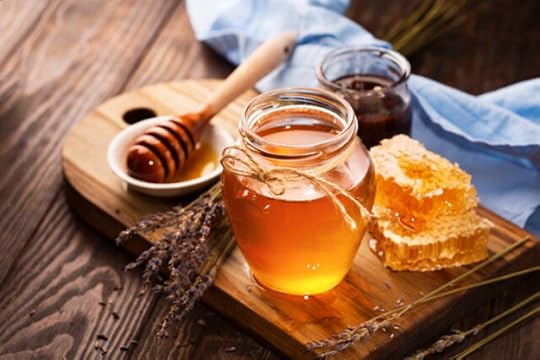 I pride myself on making the Primal Blueprint an easy-to-follow lifestyle. If you were just starting out, I could give you a one-page handout with the 10 Primal Blueprint Laws, the PB Food Pyramid, and the PB Fitness Pyramid, and it would be pretty easy for you to get the gist of everything we’re trying to do here.
I pride myself on making the Primal Blueprint an easy-to-follow lifestyle. If you were just starting out, I could give you a one-page handout with the 10 Primal Blueprint Laws, the PB Food Pyramid, and the PB Fitness Pyramid, and it would be pretty easy for you to get the gist of everything we’re trying to do here.
That said, once you get past the basics, sometimes things get a little murky. Like with honey.
See, as a general rule, I am against the consumption of refined sugars, especially sucrose and high fructose corn syrup (HFCS). Check out my definitive post on the subject to understand why. But what about the preeminent unrefined natural sweetener, the rich amber nectar that’s been available to humans from the very start (albeit protected by barbed, flying suicide stingers)?https://pubmed.ncbi.nlm.nih.gov/31995...
People have been using honey for thousands of years not only as a culinary ingredient but also for its supposed medicinal properties. Must we eschew honey simply because it is sweet, even if it has numerous (potential) benefits? Are some of the harmful effects of the sugar mitigated by the presence of bioactive compounds?
Personally, I enjoy some honey now and then. Let’s find out if you’ll come down on the pro-honey or anti-honey side of the debate after reviewing some evidence.
Is Honey Good for You?I get asked this from time to time, and I always respond, “Define ‘good.’”
Better, and more interesting, questions are:
Does honey have any beneficial effects that make it worth consuming?Is honey better for you than other sweeteners?Is honey a “health food” that you should make a concerted effort to include in your diet?I’ll save you time by telling you that I think the answers are probably, maybe, and probably not, respectively. If you want more detail, keep reading.
Types of HoneyBefore getting into the question of benefits, you must understand that there are many different types of honey. The attributes of any particular batch —flavor, color, consistency, and nutrient and antioxidant profile—depend on what plants the honeybees pollinated. There’s buckwheat honey, wildflower honey, clover honey, and tupelo honey, to name a few. Don’t forget about the darling of the alt-health world, manuka honey, which comes from bees in Australia and New Zealand that pollinate the Leptospermum scoparium bush. (Fun fact: Australia and New Zealand are locked in a heated battle over whether Australian-sourced manuka honey is the real deal.https://www.theguardian.com/world/202...) Honey aficionados will want to seek out the rare purple honey and black honey varieties, which, as the names suggest, do not have the characteristic golden hue.
Beyond the assorted varieties, the honey you pick up at your local grocery store or farmer’s market may be raw or refined. Raw honey is only lightly strained to remove debris, typically. It will still contain small pieces of honeycomb as well as bee propolis (aka “bee glue”), pollen, and royal jelly. Propolis and royal jelly are prized in their own right for their supposed health benefits.https://www.ncbi.nlm.nih.gov/pmc/arti... Raw honey often looks cloudy or crystallized.
In contrast, honey not labeled as raw has almost certainly undergone additional filtration plus pasteurization, which can remove or destroy the very compounds that make honey so desirable.https://www.tandfonline.com/doi/full/... Worse, the inexpensive honey you find at the store may not be pure honey at all but a mix of other sweet, viscous liquids like rice syrup or high-fructose corn syrup. Gross.
All things being equal, I’m always partial to less processed versions of any food. I want access to all the compounds that nature included, and honey is no exception. I also opt for darker honey because it is typically higher in bioactive compounds and has greater antioxidant activity.https://pubag.nal.usda.gov/catalog/74... https://www.tandfonline.com/doi/abs/1... It also tastes better, if you ask me.
Potential Health Benefits of HoneyI’m hesitant to make any sweeping claims about the health benefits of honey because there are so many types. Also, honeybees don’t exactly have strict manufacturing standards. The characteristics of a given batch of honey vary based on region, season, and probably other factors I’m not aware of.
That said, there’s quite a lot of evidence that honey and its constituents have antiinflammatory, antioxidant, antibacterial, antifungal, anticancer, and immune-boosting properties, to name a few.https://www.ncbi.nlm.nih.gov/pmc/arti... However, if you’re hoping for something specific, you can’t necessarily grab any jar off the shelf and expect it to deliver the desired effects. https://www.ncbi.nlm.nih.gov/pmc/arti... You’re going to need to dig into the research yourself and see what types may or may not be the most helpful.
Here, I’ll briefly cover some of the most common uses and purported benefits.
Honey for Sore Throat, Cough, and Respiratory InfectionsWhen I was a kid, my mom would have me swallowing big glugs of honey at the first sign of a sore throat or tightness in my chest. I rarely get sick anymore, but when I do, one of the first signs I’m coming down with something is that I crave hot tea with honey.
It makes sense that honey would be able to knock out a sore throat thanks to its antibacterial and anti-inflammatory properties, but there aren’t a lot of studies to back up this folk wisdom.
With regards to cough, the (limited) research suggests that my mom was on to something. A 2018 Cochrane review, which included nine randomized controlled trials and more than 1,000 study participants—all kids—concluded that honey seems to be equivalent to or better than standard pharmaceutical treatments. However, the authors noted that the majority of the studies only followed the patients for one night.https://www.cochranelibrary.com/cdsr/...
Another meta-analysis of studies looking at upper respiratory tract infections in kids concluded, “Honey was superior to usual care… It provides a widely available and cheap alternative to antibiotics.”https://ebm.bmj.com/content/26/2/57&q... Good news for those of us who are leery about rushing to antibiotics at the first sign of illness. Even the CDC recommends using honey for chest colds with cough in adults and kids older than one.https://www.cdc.gov/antibiotic-use/br...
I’ll stick with my honey tea next time my chest starts to feel tight, although I might try honey in coffee instead. One obscure study found that honey with coffee was more effective than honey or coffee alone and more effective than prednisone for alleviating coughs in adults following upper respiratory tract infections.https://eprints.bmsu.ac.ir/5776/"...
Honey for CancerThere’s quite a bit of promising data that suggests honey could be useful in fighting various forms of cancer. Much of the current research aims to understand how, exactly, honey exerts antitumor and cytotoxic (cell-killing) effects. Proposed mechanisms include reducing oxidative stress, preventing the proliferation of cancer cells, inhibiting cancer-causing genetic mutations, and promoting apoptosis (programmed cell death).https://www.ncbi.nlm.nih.gov/pmc/arti... https://pubmed.ncbi.nlm.nih.gov/30639...
While the research is fascinating, almost all the relevant studies have been done in vitro, meaning that they looked at cancer cells in petri dishes. It remains to be seen how this might translate into actual cancer therapies in humans. How great would it be if we could just eat fistfuls of honey, Winnie the Pooh style, and solve the cancer epidemic? Alas, that’s too good to be true. Far more likely, scientists will isolate specific bioactive compounds within honey and find ways to harness their effects.
Honey for SkincareHoney turns out to be great for your skin. It can help with everything from diaper rash to dandruff to wrinkles, again thanks in large part to its anti-inflammatory, antimicrobial, and antioxidant properties.https://pubmed.ncbi.nlm.nih.gov/24305...
Honey has long been used in dressings for burns, boils, surgical incisions, ulcers, and other types of skin afflictions. The consensus seems to be that while more research is needed,https://www.ncbi.nlm.nih.gov/pmc/arti... https://www.cochrane.org/CD005083/WOU... honey shows significant promise as a topical wound treatment. Honey produces hydrogen peroxide, which seems to account for much of its infection-fighting capability. Certain honeys are even effective against drug-resistant bacteria like MRSA.https://pubmed.ncbi.nlm.nih.gov/22347... It seems to stimulate the immune system to speed up the natural healing process and helps the body’s own enzymes break down dead tissues around the wound that can lead to infection, a process known as autolytic debridement.https://citeseerx.ist.psu.edu/viewdoc...
You can get over-the-counter honey dressings—bandaids infused with honey, essentially—if you want to see what all the fuss is about for yourself.
(Local) Honey for AllergiesAny hayfever or seasonal allergy sufferer has heard that the best natural treatment is honey. But it has to be local honey, because you need the honeybees to have been collecting nectar from the same plants that are causing your sneezing and itchy eyes. So the logic goes anyway. It’s all very homeopathic, but does it work?
I found three studies that speak to this question, and the results are inconsistent:
Forty individuals with allergic rhinitis (hayfever) took an antihistamine for four weeks along with a daily dose of either honey or honey-flavored corn syrup.https://pubmed.ncbi.nlm.nih.gov/24188... At the end of the four weeks, both groups’ symptoms had improved, but the group who ate the honey reported feeling significantly better four weeks after that. In other words, the positive effects seemed to persist only in the honey group. It’s worth noting, though, that the participants were consuming huge amounts of honey—1 gram per kilogram of bodyweight, which equates to more than three tablespoons per day for someone who weighs 150 pounds!In another study, 36 patients with allergic rhinoconjunctivitis took one tablespoon of unpasteurized, unfiltered local honey; filtered, pasteurized, non-local honey; or honey-flavored corn syrup.https://pubmed.ncbi.nlm.nih.gov/11868... The study lasted for 30 weeks, but a third of the participants ended up dropping out, presumably because they couldn’t stand the sweet regimen. At the end of the study, neither honey group reported being any better off symptom-wise than the control group. Finnish researchers recruited 44 people with birch pollen allergies.https://pubmed.ncbi.nlm.nih.gov/21196... They all received unpasteurized, unfiltered local honey that either was or was not fortified with birch pollen. Over two months, both groups had more symptom-free days compared to a control group who got no honey. However, the pollen-enhanced group had significantly fewer total symptoms, and they were less likely to need antihistamines during the study period.That’s hardly a slam dunk. The Finnish study is promising, but I’m not convinced that eating jars of honey for months at a time is a great trade-off for a modicum of allergy relief, especially if the outcome isn’t assured.
What about the Fructose in Honey? Isn’t Fructose Bad for You?Honey is 40 percent fructose and 30 percent glucose. The remaining 30 percent comprises water, pollen, and over a hundred other compounds, including enzymes, minerals, amino acids, and vitamins. Table sugar, which is sucrose, contains half fructose, half glucose, and none of the good stuff. So right off the bat, it doesn’t make much sense to uniquely worry about the fructose in honey.
That aside, the ancestral community has long accepted as fact that fructose is the most harmful form of sugar because of the way it is metabolized in the liver. Some folks—members of the carnivore community, in particular—are challenging that notion. They argue (correctly) that honey is an animal product that has long been a part of the human diet. It continues to be a staple for modern hunter-gatherers like the Hadza, who derive between 15 and 50 percent of their calories from honey—or, more precisely, honey and bee larvae. Yet the Hadza remain largely free of so-called diseases of civilization, including diseases linked to excess fructose consumption, such as metabolic syndrome and non-alcoholic fatty liver disease.https://www.ncbi.nlm.nih.gov/pmc/arti...
This gets into some thorny science (par for the course in the nutrition world), but when it comes to fructose, it seems the poison is in the dose and the delivery method. There’s no doubt in my mind that consuming large quantities of fructose, especially in the context of a high-sugar, hypercaloric diet, poses significant health risks. High-fructose corn syrup, especially beverages sweetened with HFCS, should be strictly avoided. Nothing about our evolutionary history has prepared our genes for large boluses of highly concentrated, liquid fructose.
I’m far less concerned about relatively small amounts of fructose consumed in the context of low-to-moderate-carb, eucaloric or hypocaloric Primal diets, where the fructose comes packaged in whole foods like fruit and honey. Presumably, you aren’t eating multiple tablespoons of honey at a time day in and day out (unless you’re Paul Saladino, maybe).
I’m not saying anyone needs to consume honey (or fruit, for that matter). People who already struggle with metabolic syndrome or type 2 diabetes should be mindful of how much they’re eating.https://pubmed.ncbi.nlm.nih.gov/33552... (I should note here that some scientists believe that honey may actually be antidiabetic, though the jury is still out.https://www.ncbi.nlm.nih.gov/pmc/arti...) Likewise, anyone who suffers from fructose malabsorption and intolerance, which can lead to IBS-like symptoms,https://www.ncbi.nlm.nih.gov/pmc/arti... should tread lightly with fruit and honey.
The Verdict: Is Honey Good for You?Let’s return to the three questions I posed at the beginning of this post:
Does honey have any beneficial effects that make it worth consuming?Overall, I think the answer is yes, but with a significant caveat.
Honey isn’t a panacea that is going to solve all the world’s major health problems. Still, honey (as well as bee propolis and royal jelly) is clearly anti-inflammatory, antioxidant, and antibacterial, and it seems to have various antitumor and anticancer properties. Another benefit I haven’t mentioned yet is that honey acts as a prebiotic, meaning it can promote gut health by stimulating the growth of beneficial microbes. https://academic.oup.com/fqs/article/... https://pubmed.ncbi.nlm.nih.gov/10849...
While that’s all fantastic, I wouldn’t venture to make specific recommendations regarding what types of honey, or how much, might be optimal for you. That depends on your goals and your current metabolic health.
Is honey better for you than other sweeteners?I’d say yes, particularly if we’re talking about honey compared to table sugar or pure glucose or fructose.
Overall, honey doesn’t seem to have the same downsides as other sweeteners. For example, one set of studies compared the effects of honey, sham-honey (a mix of fructose and glucose), dextrose (which is just glucose), and sucrose on several health markers in various groups of people.https://pubmed.ncbi.nlm.nih.gov/15117... There’s a lot to wade through, but the gist is that honey performed well. Honey resulted in smaller blood glucose spikes (+14%) than dextrose (+53%). Sham honey increased triglycerides, while real honey lowered them (along with boosting HDL and lowering LDL). After fifteen days of honey feeding, CRP and LDL dropped. Overall, honey improved blood lipids, lowered inflammatory markers, and had minimal effect on blood glucose levels.
That said, it surely depends on the context. It’s safe to say that honey is better than table sugar across the board, especially, it seems, for diabetics.https://www.hindawi.com/journals/omcl... However, someone trying to maintain a strict caloric deficit may prefer a low-calorie or noncaloric sweetener like stevia, monk fruit, or erythritol. By the same token, the carbohydrates in honey might offset any potential upsides for folks following a ketogenic diet.
Is honey a “health food” that you should make a concerted effort to include in your diet?I’m not sure “should” is the right word here. I’ll continue to use honey as a home remedy for sore throats and coughs, and I’ll enjoy the occasional honey-sweetened dessert. But will I go out of my way to consume honey to ward off health problems or otherwise stay healthy? No, I don’t think the available evidence justifies that.
Bottom line: Can you eat it? Sure. Should you eat it? It depends. There’s no doubt in my mind that honey is an ancestral food, meaning that our long-ago ancestors enjoyed honey when it was available. So if that’s the criteria you use to decide whether a particular food deserves a place in your kitchen, the answer is yes, go for it.
At the end of the day, I prefer to minimize my intake of all sweeteners, mostly because I choose to prioritize savory foods (mmm, steak). If you’re going to consume honey, which is fine in my book, go for the raw, unfiltered stuff, as dark as you can get.
What do you think? Does honey fit into your way of eating? Is it Primal? Let me know what you think.
FAQs About HoneyIs honey allowed on a vegan diet? What about a carnivore diet?This is a heated debate within both the vegan and carnivore communities. Many, but not all, vegans say no because harvesting honey potentially exploits or harms honeybees. Some carnivores do eat honey, arguing that it qualifies as an “animal product” since it is produced by bees. Most still do not.
Can honey be organic?The U.S. has no official standard for certifying honey as organic. Small-scale producers may label their honey as organic, but any certified organic honey must be imported. Nevertheless, in practice, it is difficult to impossible to ensure that honeybees are only collecting nectar from organic plants.
Can you eat honey on a keto diet?Ketogenic diets allow up to 50 grams of carbohydrates per day. A teaspoon of honey only contains 6 grams of carbohydrates, and it seems to provoke a smaller blood glucose response than pure glucose.https://pubmed.ncbi.nlm.nih.gov/24605... https://pubmed.ncbi.nlm.nih.gov/17887... Therefore, honey can probably be enjoyed in moderation on keto.
Can I substitute honey for sugar in Primal, Paleo, or Keto recipes?Yes, though you may need to adjust the recipe. Honey is sweeter than refined sugar, so start with half as much honey as sugar. In baked goods, you will also need to reduce the other liquids in the recipe and add baking soda to counteract honey’s natural acidity.
If you’re using honey in keto recipes, keep in mind that honey is not a low-calorie or low-carb sweetener. You’ll need to count those carbs toward your daily total, and even moderate amounts will add up quickly.
Is raw honey better for you than refined or processed honey?Raw honey contains pollen, bee propolis, and royal jelly, which have a host of beneficial properties in their own right. Refined honey removes those compounds via filtration and pasteurization. Pasteurization may also damage enzymes and other components you want in your honey. Opt for raw whenever possible.
(function($) { $("#dfObEI6").load("https://www.marksdailyapple.com/wp-ad..." ); })( jQuery ); References https://pubmed.ncbi.nlm.nih.gov/31995815/https://www.theguardian.com/world/2021/sep/04/new-zealand-and-australia-prepare-to-do-battle-again-over-treasured-and-lucrative-manuka-honeyhttps://www.ncbi.nlm.nih.gov/pmc/articles/PMC5549483/https://www.tandfonline.com/doi/full/10.1080/10942910600981708https://pubag.nal.usda.gov/catalog/749162https://www.tandfonline.com/doi/abs/10.1080/00218839.1998.11100951https://www.ncbi.nlm.nih.gov/pmc/articles/PMC5549483/https://www.ncbi.nlm.nih.gov/pmc/articles/PMC8300703/https://www.cochranelibrary.com/cdsr/doi/10.1002/14651858.CD007094.pub5/pdf/fullhttps://ebm.bmj.com/content/26/2/57https://www.cdc.gov/antibiotic-use/bronchitis.htmlhttps://eprints.bmsu.ac.ir/5776/https://www.ncbi.nlm.nih.gov/pmc/articles/PMC3865795/https://pubmed.ncbi.nlm.nih.gov/30639116/https://pubmed.ncbi.nlm.nih.gov/24305429/https://www.ncbi.nlm.nih.gov/pmc/articles/PMC32305/https://www.cochrane.org/CD005083/WOUNDS_honey-as-a-topical-treatment-for-acute-and-chronic-woundshttps://pubmed.ncbi.nlm.nih.gov/22347223/https://citeseerx.ist.psu.edu/viewdoc/download?doi=10.1.1.523.8889&rep=rep1&type=pdfhttps://pubmed.ncbi.nlm.nih.gov/24188941/https://pubmed.ncbi.nlm.nih.gov/11868925/https://pubmed.ncbi.nlm.nih.gov/21196761/https://www.ncbi.nlm.nih.gov/pmc/articles/PMC3587472/https://pubmed.ncbi.nlm.nih.gov/33552217/https://www.ncbi.nlm.nih.gov/pmc/articles/PMC5817209/https://www.ncbi.nlm.nih.gov/pmc/articles/PMC3471321/https://academic.oup.com/fqs/article/1/2/107/3860141?login=truehttps://pubmed.ncbi.nlm.nih.gov/10849275/https://pubmed.ncbi.nlm.nih.gov/15117561/https://www.hindawi.com/journals/omcl/2018/4757893https://pubmed.ncbi.nlm.nih.gov/24605717/https://pubmed.ncbi.nlm.nih.gov/17887941/
References https://pubmed.ncbi.nlm.nih.gov/31995815/https://www.theguardian.com/world/2021/sep/04/new-zealand-and-australia-prepare-to-do-battle-again-over-treasured-and-lucrative-manuka-honeyhttps://www.ncbi.nlm.nih.gov/pmc/articles/PMC5549483/https://www.tandfonline.com/doi/full/10.1080/10942910600981708https://pubag.nal.usda.gov/catalog/749162https://www.tandfonline.com/doi/abs/10.1080/00218839.1998.11100951https://www.ncbi.nlm.nih.gov/pmc/articles/PMC5549483/https://www.ncbi.nlm.nih.gov/pmc/articles/PMC8300703/https://www.cochranelibrary.com/cdsr/doi/10.1002/14651858.CD007094.pub5/pdf/fullhttps://ebm.bmj.com/content/26/2/57https://www.cdc.gov/antibiotic-use/bronchitis.htmlhttps://eprints.bmsu.ac.ir/5776/https://www.ncbi.nlm.nih.gov/pmc/articles/PMC3865795/https://pubmed.ncbi.nlm.nih.gov/30639116/https://pubmed.ncbi.nlm.nih.gov/24305429/https://www.ncbi.nlm.nih.gov/pmc/articles/PMC32305/https://www.cochrane.org/CD005083/WOUNDS_honey-as-a-topical-treatment-for-acute-and-chronic-woundshttps://pubmed.ncbi.nlm.nih.gov/22347223/https://citeseerx.ist.psu.edu/viewdoc/download?doi=10.1.1.523.8889&rep=rep1&type=pdfhttps://pubmed.ncbi.nlm.nih.gov/24188941/https://pubmed.ncbi.nlm.nih.gov/11868925/https://pubmed.ncbi.nlm.nih.gov/21196761/https://www.ncbi.nlm.nih.gov/pmc/articles/PMC3587472/https://pubmed.ncbi.nlm.nih.gov/33552217/https://www.ncbi.nlm.nih.gov/pmc/articles/PMC5817209/https://www.ncbi.nlm.nih.gov/pmc/articles/PMC3471321/https://academic.oup.com/fqs/article/1/2/107/3860141?login=truehttps://pubmed.ncbi.nlm.nih.gov/10849275/https://pubmed.ncbi.nlm.nih.gov/15117561/https://www.hindawi.com/journals/omcl/2018/4757893https://pubmed.ncbi.nlm.nih.gov/24605717/https://pubmed.ncbi.nlm.nih.gov/17887941/The post Is Honey a Safe(r) Sweetener? appeared first on Mark's Daily Apple.


November 27, 2021
Mark’s Big-Ass Keto Salad
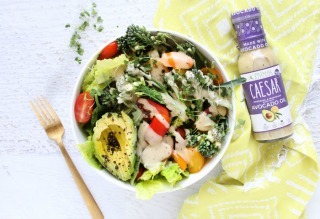 For years now, all those who know me (including readers of the blog) have heard me talk about my daily “big-ass salad.” It’s been my lunch of choice for a couple of decades at least, and I don’t see that ever changing. Over the years I’ve adapted it to my personal tastes, nutritional experiments, and—lately—my keto practice.
For years now, all those who know me (including readers of the blog) have heard me talk about my daily “big-ass salad.” It’s been my lunch of choice for a couple of decades at least, and I don’t see that ever changing. Over the years I’ve adapted it to my personal tastes, nutritional experiments, and—lately—my keto practice.
Some people minimize vegetable intake when they’re eating keto. I’ve never found that necessary or beneficial. In fact, I highly recommend plenty of above-ground vegetables and even berries for an optimally varied, nutrient-dense keto diet. That’s my Primal take because personally I practice keto with an eye toward strategy, not restriction.
So, what about the fat? With fat comprising up to 75% of keto energy sourcing, you can bet we’re talking about more than lettuce. This salad is no side dish for sure. I get a large portion of my fat intake from it every day—keto weeks included. With a whole avocado, a generous chunk of Emmental cheese (my favorite cheese when I’m in ketosis), and a hefty (i.e. jaw-dropping) dose of my own PRIMAL KITCHEN® Caesar Dressing with all the rich goodness of avocado oil, I literally call this my fat bomb salad. See if it won’t make you a keto salad believer.
Ingredients:
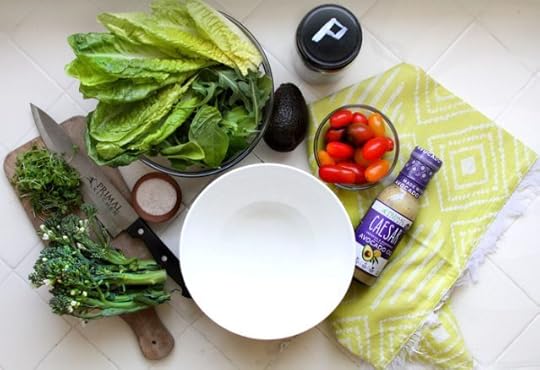
Instructions:

Toss together the cut vegetables with mixed greens. Shave my favorite cheese, Emmental, over the entire salad. Smother with PRIMAL KITCHEN® Caesar Dressing (no skimping allowed). Then enjoy.
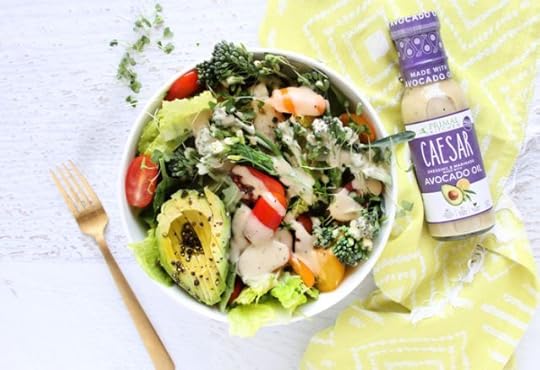

The post Mark’s Big-Ass Keto Salad appeared first on Mark's Daily Apple.


November 22, 2021
How to Clean Out Your Kitchen and Go Primal
 Most people find their way to the Primal Blueprint via food. They’re looking to start eating “right” and get healthy. Maybe they ask a few friends whose lifestyles they admire, or they Google a few buzzwords—low-carb, paleo, keto—and eventually make their way here. However they get here, I love the unbridled enthusiasm of someone on the precipice of change. They’re ready to listen and do whatever you advise. Just say the word. And when they ask where to begin, the word I say is: purge.
Most people find their way to the Primal Blueprint via food. They’re looking to start eating “right” and get healthy. Maybe they ask a few friends whose lifestyles they admire, or they Google a few buzzwords—low-carb, paleo, keto—and eventually make their way here. However they get here, I love the unbridled enthusiasm of someone on the precipice of change. They’re ready to listen and do whatever you advise. Just say the word. And when they ask where to begin, the word I say is: purge.
Any good Primal transformation starts by eliminating the “big three” health offenders: grains, sugar, and industrialized seed oils (canola, corn, safflower, soybean, etc.). Get rid of the foods you no longer intend to eat to make room for the meat, eggs, vegetables, fruits, healthy fats, nuts, seeds that comprise the Primal Blueprint Food Pyramid.
If you intend to start eating differently, you have set up your environment for success. This is habit change 101.
Want to stop eating so much sugar? Toss all the candy, ice cream, and whoopie pies, and stock up on protein-rich snacks and 85 percent dark chocolate instead.
Need to kick that soda habit? Say sayonara to the soda, buy some sparkling water, and stop taking the elevator at work that drops you off by the vending machines.
During our 21-day Primal Resets or Keto Month challenges, one of the very first things we ask participants to do is a pantry purge for this very reason. On the surface, it’s pretty simple: get rid of the big three, plus any products made with them. Except it’s not that simple. Nothing ever is. We always get a lot of questions about how, exactly, to undertake the pantry purge. Hence today’s post. I’m not going to cover what to purge when you clean out your pantry. This older post covers that in great detail. Today is about strategy and how to navigate the sometimes thorny complexities here.
First, Stop Buying Stuff You’ll Have to Throw Out LaterLet’s say you’re not quite ready to start eating Primally yet. You’re taking your time learning about the Primal Blueprint, or you’re waiting until January, your birthday, or after that vacation you have planned for next month. That’s fine. In the meantime, though, give your future self a leg up by buying fewer chips, frozen desserts, and cases of energy drinks starting now.
So often, people feel the need to go on a junk food bender (whatever that means to you) before “getting healthy.” That’s a self-sabotaging mentality that starts you off on the wrong foot. The implication is that you’re leaving the good life behind and jumping into something less desirable. I take exception to that. Primal eating isn’t boring, you shouldn’t feel deprived, and it’s certainly not a punishment. You don’t need to throw yourself whatever the food equivalent of a bachelor party is.
Resist the urge to go out on a bang, and save yourself some money by not filling your pantry with things you will have to purge when you’re ready to take the leap.
Go Big: The Ruthless PurgeIn the past, I’ve advocated what I call the “ruthless purge.” That’s where you go into your kitchen with the biggest garbage bag you can find and throw out anything with grains, excess sugar, or seed and vegetable oils. Check the fridge, freezer, pantry, cupboards, and drawers. Don’t forget the spice rack. Read every label, and if something is even a little suspect, get rid of it (recycling any recyclable packaging, of course). Start your Primal reset with a totally clean slate.
Now, I still think this is a great way to start, but I’ve occasionally gotten some pushback on this strategy that I think is valid. Let me address those concerns one at a time.
“What if I can’t afford to replace all my food at once?”In this case, a more gradual purge is in order. I’d still suggest tossing the worst offenders if you can. To me, that means things like:
Non-Primal cooking oils: the big bottles of vegetable oil, canola oil, and so onSalad dressings and other condiments made with those oilsBaking ingredients like bags of white flour, whole wheat flour, and sugarDesserts like ice cream, cookies, cakes, candyConventional snacks from the chip and cracker aisles (the better-for-you alternatives made with almond, coconut, or cassava flour excepted)Sugary breakfast cerealsEspecially for folks on a tight food budget, I’d never suggest tossing conventional eggs, meat, or produce. Yes, I personally choose grass-fed and organic when I can, but Primal is all about making the best possible choices given the options available to you. Conventional meat is always going to deliver many more benefits than marshmallow cereal.
As for the “borderline foods”—foods that aren’t strictly Primal but also aren’t the most un-Primal in the grand scheme of things—that depends on what you can afford. Maybe you eat through your existing supply of oatmeal, legumes, or rice but don’t buy more once they’re gone, at least for a while. If you suspect a particular food is triggering acute health problems, like your IBS flare-ups, for example, just get rid of it. It’s not worth it.
At the end of the day, I trust that you’re going to do the best you can. If that means eating up all the food you have in your kitchen, Primal-aligned or not, because you can’t afford to throw anything out, you won’t get any guff from me.
“I feel guilty wasting so much food.”Food waste is a huge problem and something I try hard to be conscientious about in my own life and at Primal Kitchen. So what are you supposed to do if you don’t want to throw food in the trash, but you also don’t want to eat it? The obvious answers are to donate unopened items to your local food bank or shelter. Or, use those foods to make meals for others—think new parents, elderly neighbors, friends who are sick or are recovering from surgery—or for events like office parties where a baked pasta casserole or batch of cookies would be welcomed.
When I’ve suggested this in the past, though, some people have chimed in and argued that these approaches are problematic in their own right. Why, they ask, are those foods okay for other people if they’re not good enough for you? Doesn’t giving them to food pantries exacerbate the problem of lower-income folks having more access to hyper-processed, less nutritious food than they have to meat and produce? I see this point, but I also think the issue is far more complicated than that. Frankly, I see both sides and don’t have the definitive answer here. You’ll have to decide where you come down on this debate. (Feel free to hash it out in the comments). One compromise option might be to donate your toaster strudels and pasta along with canned fish, canned vegetables, and a monetary donation, which many food banks will use to buy perishable items.
You always have the option of doing the gradual purge described above. Ask yourself what feels like the lesser evil: eating foods you no longer want or throwing them away. It might be a hard choice. Remember this and use it as incentive to keep these items out of your kitchen in the future so you don’t have to go through this again.
“My partner/roommates/kids will be furious if I throw away their favorite food.”“What if the people I live with aren’t on board with my new way of eating?” We get this question all the time during our Primal challenges*, and it’s a toughie.
First things first, don’t throw away their non-Primal favorites if they haven’t committed to going Primal with you. That will just breed conflict and resentment.
Still, it’s perfectly understandable if you want the cookies, potato chips, and soda out of sight and out of mind. Communication is vital here. Explain why you’re making the changes you’re making and what your housemates can do to support you. I’ve found the best strategy is to create kitchen zones. Let them have their foods, but keep them separate from yours, ideally in a specific cupboard that you don’t open.
You can’t force other people to go along with your Primal diet, no matter how much you want them to. Lead by example, and hopefully they’ll start to come around in time. In the meantime, keep your eyes on your own plate. (And no, it’s not easy. My colleague Erin Power has some more great tips for dealing with unsupportive partners.)
*Speaking of Primal challenges, watch this space for forthcoming announcements about our January plans!
That’s it from me. I’d love to hear about your experiences going Primal. When it came to diet, did you jump in with both feet or make gradual changes? Would you do it differently if you had to do it over?
(function($) { $("#dfJ9Rim").load("https://www.marksdailyapple.com/wp-ad..." ); })( jQuery ); 
The post How to Clean Out Your Kitchen and Go Primal appeared first on Mark's Daily Apple.


November 20, 2021
Low Carb and Keto Alternatives to Mashed Potatoes
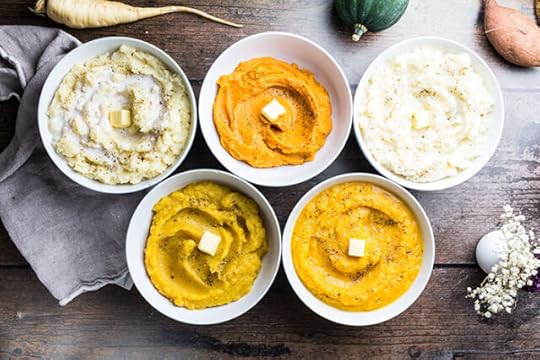 Mashed potatoes are almost expected as part of a holiday spread. In fact, I would argue that mashed potatoes appear on more holiday tables than a turkey or roast, because even vegans will serve them. But, if you’ve been living more ancestrally and you’ve been keeping your carbs low, you may be looking for a low-carb alternative to mashed potatoes.
Mashed potatoes are almost expected as part of a holiday spread. In fact, I would argue that mashed potatoes appear on more holiday tables than a turkey or roast, because even vegans will serve them. But, if you’ve been living more ancestrally and you’ve been keeping your carbs low, you may be looking for a low-carb alternative to mashed potatoes.
Whether you’re trying to lower your carb intake or just switch things up, why not try a different vegetable mash this season? Not to worry, each of these options makes a great vehicle for gravy, and we’re all in it for the gravy anyway, aren’t we?
Carbs in Mashed PotatoesOne cup of mashed potatoes contains 36.9 g of carbohydrates.https://www.carbmanager.com/food-deta... After you subtract the fiber, you’re left with 33.6 g net carbs in mashed potatoes.
If you’re limiting carbs, just one serving of traditional mashed potatoes doesn’t leave room for much else.
Low-carb and Keto Alternatives to Traditional Mashed PotatoesCauliflower: 3.2g net carbs per cupBroccoli: 3.6g net carbs per cupSpaghetti squash: 5.5g net carbs per cupTurnips: 6.1g net carbs per cupPumpkin: 6.9g net carbs per cupCarrots: 8.7g net carbs per cupRutabaga: 8.9g net carbs per cupCelery Root: 11.6g net carbs per cupButternut squash: 13.6g net carbs per cupParsnip: 17.4g net carbs per cupAcorn squash: 21g net carbs per cupSweet potato: 22.8g net carbs per cup
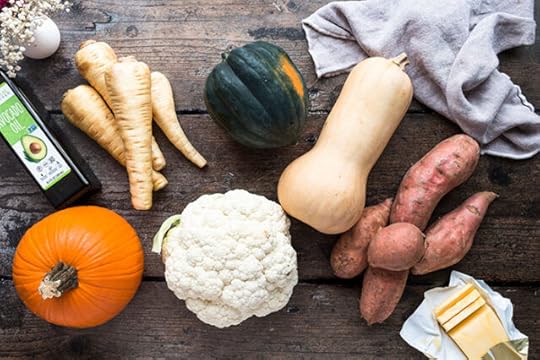
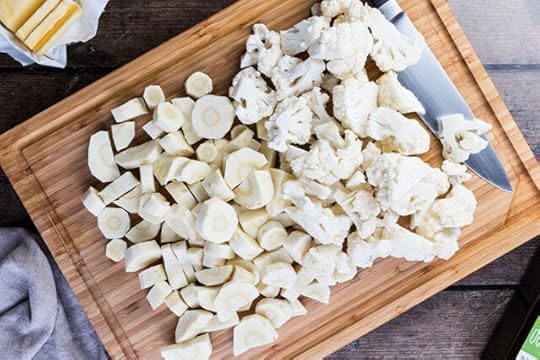
This option will work for any of the above veggies. Simply peel, slice, or chop your vegetable into uniform 1-inch pieces and fill a pot with water and bring to a boil on the stovetop. Carefully place the veggies in the water if boiling them or lower them into a steamer basket if steaming. The total time will vary depending upon the vegetable and how large you cut them, but once they are fork-tender, strain out the water and place the soft veggie pieces back into the pot.
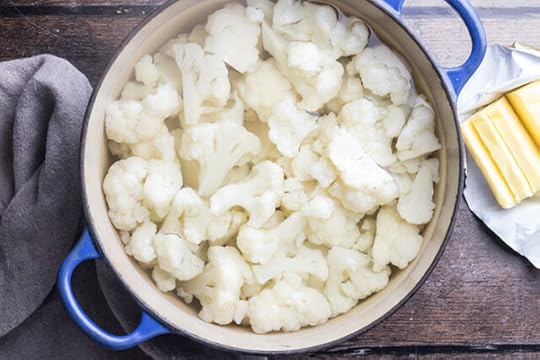
Roasting will work best for winter squash and sweet potato. Cut your squash in half or cubes and drizzle with avocado oil. Place on a sheet pan and roast in a 375-degree oven until tender. Scoop out the flesh.
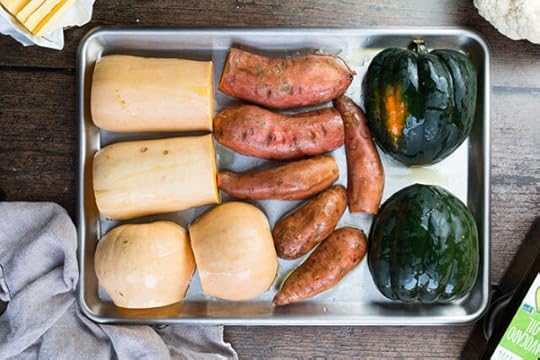
Place your veggies back in the pot you boiled them in or in a large bowl if you roasted them. Use a potato masher to begin to mash the veggies.
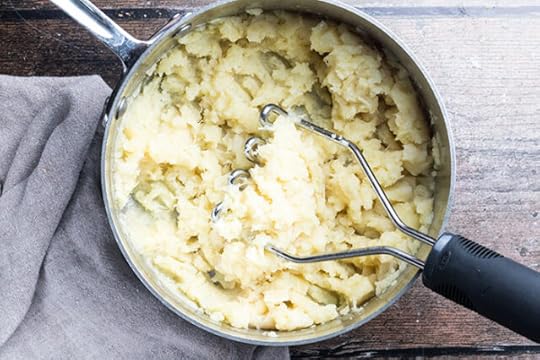
Add a few tablespoons of butter and a little milk or dairy-free milk as needed to mash into a smooth texture. Some vegetables will mash more smoothly than others so the amount of time this takes will vary. Season with salt and pepper and you’re ready to eat!
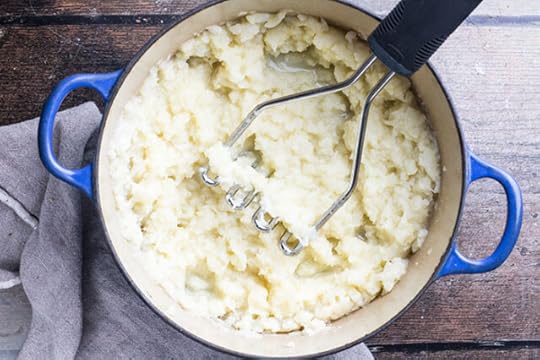
Place the boiled or roasted veggies in a food processor. Add butter and pulse or turn the processor on and begin processing the vegetables. Add a little milk or dairy-free milk if needed to achieve the proper consistency. Season with salt and pepper to taste.
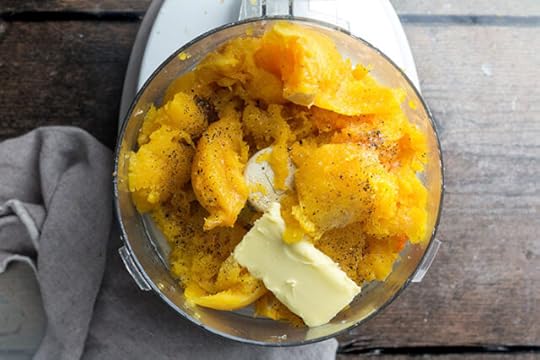
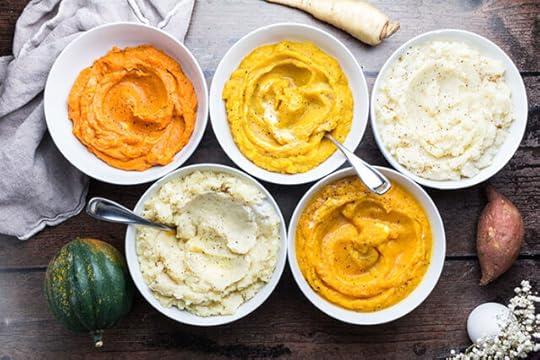
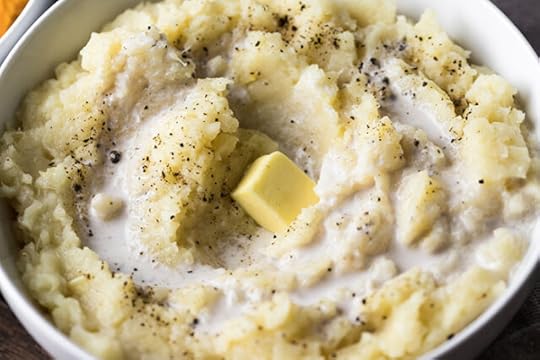
Because potatoes contain over 30 g of carbs per cup, potatoes are not considered keto. You would have to eat an extremely small, unsatisfying amount of potatoes to stay in ketosis.


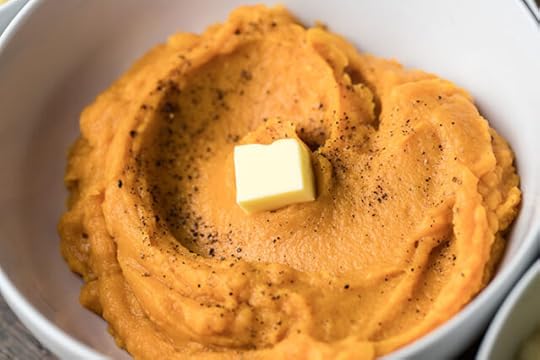
(function($) { $("#df8uYPK").load("https://www.marksdailyapple.com/wp-ad..." ); })( jQuery ); 
The post Low Carb and Keto Alternatives to Mashed Potatoes appeared first on Mark's Daily Apple.


November 19, 2021
New and Noteworthy: What I Read This Week—Edition 155
 Research of the Week
Research of the Week
Modeling the effect of a leaky vaccine plus enhanced transmission viral variants.
Palmitic acid on trial again. I suppose I’ll have to address this.
Zinc works against cold and flu.
A little alcohol can curb inflammatory markers.
Everyone deserves full access to research.
New Primal Kitchen PodcastsEpisode 7: Farmlink—How a College Non-Profit Sparked Monumental Community Change: Morgan talks the founders of Farmlink.
Primal Health Coach Institute: Dr. Gabrielle Lyon.
Media, SchmediaHow has Africa escaped (largely) COVID?
Portugal takes work life balance seriously.
Interesting Blog PostsDoes linoleic aid induce obesity?
IV vitamin C works. Why aren’t we using it?
Social NotesRIP.
Always look at all-cause mortality.
Everything ElseVirtual reality for back pain.
The FDA sure moves slow.
I can’t imagine a reason why not.
Things I’m Up to and Interested InKnew it: The health benefits of grandmas.
Interesting podcast: Andrew Huberman chats with a light and circadian rhythm expert.
Interesting business hack: Giant eggs.
Interesting research: Human evolution sped up the last 3000 years in response to rapid environmental shifts.
Hard to accept: Does parenting have an effect?
Question I’m AskingWould you try VR for back pain?
Recipe CornerPaleo Thanksgiving recipes.Pumpkin pie bites.Time CapsuleOne year ago (Nov 13 – Nov 19)
Guide to Organ Meats— All about them.How to Choose the Best Olive Oil— How to do it.Comment of the Week
“Whoa the berserker rage essay was fascinating. I’m a long time cop in a fairly violent metropolitan city. I’ve always thought myself to be empathetic in nature but when I look back on some use of forces I was duty bound to do, it baffles me. Like it wasn’t really me doing that. Or I displayed much more strength than I believe I’m capable of in the weightlifting room. Conversely, I have absolutely experienced (on the receiving end) what’s known as “excited delerium.” Cops always know it’s ED when 911 callers mention the person is naked and “he’s growling like a dog.” There’s never enough cops to subdue a man like that. It’s unbelievable the strength they have. Long ago we had no idea what caused them to so often stop breathing after being handcuffed. Awareness is out there now but almost no formal training for cops on how to physically handle before/after contact. Mostly on the job training. Anyways, great article.”
-Interesting comment!
(function($) { $("#dfZKw3K").load("https://www.marksdailyapple.com/wp-ad..." ); })( jQuery ); 
The post New and Noteworthy: What I Read This Week—Edition 155 appeared first on Mark's Daily Apple.


November 18, 2021
Study: The Link between Body Temperature and Physical Activity
 I used to offer extended commentary on new research in a weekly series called “Monday Musings.” I’d cover and summarize a study or two or three, give some commentary, and open it up for questions from the readers. It was a fun and informative way to spend a Monday. Well, with more and more research being published than ever before, and more and more people being interested in health than ever before, I figured I’d resurrect the practice and begin analyzing new research in brief, digestible chunks.
I used to offer extended commentary on new research in a weekly series called “Monday Musings.” I’d cover and summarize a study or two or three, give some commentary, and open it up for questions from the readers. It was a fun and informative way to spend a Monday. Well, with more and more research being published than ever before, and more and more people being interested in health than ever before, I figured I’d resurrect the practice and begin analyzing new research in brief, digestible chunks.
First study is “Historical body temperature records as a population-level ‘thermometer’ of physical activity in the United States.”https://www.cell.com/current-biology/...
I’m not a cold weather guy anymore. Years of living in Malibu and now Miami Beach have softened me. I’ll admit that readily. But back when I was a kid in Maine, I used to brave those cold blustery (even snowy) days without much in the way of cold weather clothing. My friends and I would stay out all day long and never stop moving, never really feeling the cold. We weren’t out there shirtless or anything, but we also weren’t wearing four layers. We weren’t bundled up.
And even now, when I go snowboarding, I can’t bundle up too heavily. If I’m really staying in motion, I’ll be in short sleeves or else I get too hot. The key is moving. All you have to do is move and the cold just bounces right off you.
That’s the basis of this new study, which uses body temperature data to gauge the level of physical activity in the United States over the last hundred years or so. The authors propose that higher body temperatures mean greater physical activity. And that’s a fairly sound conclusion, but I don’t think it’s the entire story. There are other factors that can lower body temperature.
The one that leaps out at me is our linoleic acid intake from seed oils. Over the past 50 years or so, we have eaten more seed oils than ever before and the linoleic acid content of human body fat has increased by 136%.https://academic.oup.com/advances/art...
Why does this matter?
Hibernating animals tend to massively increase their linoleic acid intake in order to deposit tons of it in their body fat in the weeks leading up to hibernation. This induces torpor, a state of low body temperature, body fat gain, and extremely low physical activity—so low that they don’t move at all.https://pubmed.ncbi.nlm.nih.gov/32528... Does that sound familiar? Brad Marshall, the “croissant diet guy,” has been focusing on how linoleic acid intake regulates torpor and thus body temperature and metabolic rate for the past couple years. It happens to all mammals, not just squirrels, bears, and mice. Humans are not exempt from the metabolism-depressing effects of excessive linoleic acid intake.
The second study is called “The effect of vitamin D and magnesium supplementation on the mental health status of attention-deficit hyperactive children: a randomized controlled trial.”https://bmcpediatr.biomedcentral.com/...
These were Iranian kids aged 6-12 with diagnosed ADHD who also had magnesium and vitamin D deficiency. One group got 50k IUs of vitamin D each week and 6 mg of magnesium/kg of body weight every day at lunch; the other group got placebo capsules and tablets. So if you were an 80 pound (roughly 36 kg) kid, you’d get 216 mg of magnesium. Sadly they didn’t mention what form of magnesium, but whatever it was, it managed to increase serum magnesium levels.
What was the result?
Kids who received vitamin D and magnesium had fewer emotional problems, behavioral issues, peer problems, and “total difficulties” than the control group received no supplements. This is a simple intervention with very little downside—in fact, the supplementation group had no side effects whatsoever, not even the upset stomach that can result from lower-quality magnesium supplements—and lots of upside. There’s a good chance that most kids have at least subclinical magnesium deficiency, and we already know that magnesium deficiency is linked to many serious conditions children suffer from, like type 1 diabetes and leukemia.5https://pubmed.ncbi.nlm.nih.gov/11342... Magnesium supplementation is a low-cost, essentially “free” intervention to try on just about every child out there.
What about magnesium from food? Sure, that’s great. Almonds, most legumes, pumpkin seeds, winter squash, fermented dairy are all pretty good sources of magnesium, but supplementation may be warranted because food magnesium levels have been dropping from historical levels. In other words, the amount of dietary magnesium our physiologies are used to getting on a historical and evolutionary basis are no longer present in most modern foods.
If you can’t get your kids to take magnesium pills, you can just work it into their diets.
Blackstrap molasses in milk.
Magnesium chloride powder sprinkled in their drinking water.
Magnesium-rich mineral water like Gerolsteiner.
Anyway, that’s what I’ve got for today. What do you think about these studies? I’m curious to hear your reactions. Until next time.
(function($) { $("#dfTLjTF").load("https://www.marksdailyapple.com/wp-ad..." ); })( jQuery ); 
The post Study: The Link between Body Temperature and Physical Activity appeared first on Mark's Daily Apple.


Mark Sisson's Blog
- Mark Sisson's profile
- 199 followers



